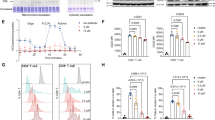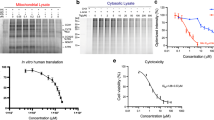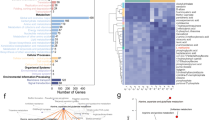Abstract
This study aims to compare the antimicrobial activity of omadacycline with tigecycline against clinical isolates of Enterococcus faecium and investigate their resistance mechanisms. Non-duplicate clinical E. faecium isolates (n = 224) were collected and the minimal inhibitory concentrations (MICs) of omadacycline and tigecycline were determined by broth microdilution method. The tet genes and the genetic mutations in 16 S rRNA genes and 30 S ribosomal protein S10 were determined by PCR and sequence alignment. The global protein abundances of the omadacycline-induced and parent isolates were determined by a Q Exactive plus mass spectrometer. The MIC50/MIC90 of omadacycline and tigecycline against the 224 E. faecium isolates were 0.25/0.5 mg l−1 and 0.125/0.25 mg l−1, respectively. Among these E. faecium isolates, the frequency of the isolates with omadacycline MICs ≥ 0.25 mg l−1 were significantly higher than that with tigecycline MICs ≥ 0.25 mg l−1. Moreover, the T1473C and/or G1468A mutations in the 16 S rRNA and Lys98Glu mutation in the 30 S ribosomal protein S10 were identified in the 3 series of tigecycline or omadacycline- nonsusceptible isolates selected in vitro. The abundances of 32 proteins changed in the omadacycline-induced isolate, of which 10 increased and 22 decreased. The abundance of tet(M) increased significantly in the omadacycline-induced isolate, and the abundance of proteins included in cellular process and metabolic process decreased. In conclusion, Omadacycline and tigecycline exhibits excellent activities against clinical isolates of E. faecium and exposure to omadacycline and tigecycline can result in significant cross-resistance to both antibiotics. The high-level expression of tet(M) in E. faecium may confer resistance to omadacycline.
This is a preview of subscription content, access via your institution
Access options
Subscribe to this journal
Receive 12 print issues and online access
$259.00 per year
only $21.58 per issue
Buy this article
- Purchase on SpringerLink
- Instant access to full article PDF
Prices may be subject to local taxes which are calculated during checkout



Similar content being viewed by others
Data availability
All data generated or analyzed during this study are included in this published article [and its supplementary information files].
The mass spectrometry proteomics data were deposited to the ProteomeXchange Consortium via the PRIDE partner repository with the dataset identifier PXD026325.
References
Arias CA, Murray BE. The rise of the Enterococcus: beyond vancomycin resistance. Nat Rev Microbiol. 2012;10:266–78.
Cattoir V, Giard JC. Antibiotic resistance in Enterococcus faecium clinical isolates. Expert Rev Anti Infect Ther. 2014;12:239–48.
Gotfried MH, Horn K, Garrity-Ryan L, Villano S, Tzanis E, Chitra S, et al. Comparison of omadacycline and tigecycline pharmacokinetics in the plasma, epithelial lining fluid, and alveolar cells of healthy adult subjects. Antimicrob Agents Chemother. 2017;61:e01135-17.
Nguyen F, Starosta AL, Arenz S, Sohmen D, Dönhöfer A, Wilson DN. Tetracycline antibiotics and resistance mechanisms. Biol Chem. 2014;395:559–75.
Cattoir V, Isnard C, Cosquer T, Odhiambo A, Bucquet F, Guérin. et al. Genomic analysis of reduced susceptibility to tigecycline in Enterococcus faecium. Antimicrob Agents Chemother. 2015;59:239–44.
Zhanel GG, Esquivel J, Zelenitsky S, Lawrence CK, Adam HJ, Golden A. et al. Omadacycline: a novel oral and intravenous aminomethylcycline antibiotic agent. Drugs. 2020;80:285–313.
Lin Z, Pu Z, Xu G, Bai B, Chen Z, Sun X, et al. Omadacycline efficacy against Enterococcus faecalis isolated in China: in vitro activity, heteroresistance, and resistance mechanisms. Antimicrob Agents Chemother 2020;64.
Draper MP, Weir S, Macone A, Donatelli J, Trieber CA, Tanaka, Levy SBSK. Mechanism of action of the novel aminomethylcycline antibiotic omadacycline. Antimicrob Agents Chemother. 2014;58:1279–83.
Villano S, Steenbergen J, Loh E. Omadacycline: development of a novel aminomethylcycline antibiotic for treating drug-resistant bacterial infections. Future Microbiol. 2016;11:1421–34.
Tanaka SK, Steenbergen J, Villano S. Discovery, pharmacology, and clinical profile of omadacycline, a novel aminomethylcycline antibiotic. Bioorg Med Chem. 2016;24:6409–19.
Pfaller MA, Huband MD, Rhomberg PR, Flamm RK. Surveillance of omadacycline activity against clinical isolates from a global collection (North America, Europe, Latin America, Asia-Western Pacific), 2010–2011. Antimicrob Agents Chemother. 2017;61.
Niebel M, Quick J, Prieto AM, Hill RL, Pike R, Huber D. et al. Deletions in a ribosomal protein-coding gene are associated with tigecycline resistance in Enterococcus faecium. Int J Antimicrob Agents. 2015;46:572–5.
Zhang F, Bai B, Xu G, Lin Z, Li G, Chen Z. et al. Eravacycline activity against clinical S. aureus isolates from China: in vitro activity, MLST profiles and heteroresistance. BMC Microbiol. 2018;18:211
Bai B, Lin Z, Pu Z, Xu G, Zhang F, Chen Z. et al. In vitro activity and heteroresistance of omadacycline against clinical Staphylococcus aureus isolates from China reveal the impact of omadacycline susceptibility by branched-chain amino acid transport system II carrier protein, Na/Pi cotransporter family protein, and fibronectin-binding protein. Front Microbiol. 2019;10:2546
Bai B, Hu K, Li H, Yao W, Li D, Chen Z, et al. Effect of tedizolid on clinical Enterococcus isolates: in vitro activity, distribution of virulence factor, resistance genes and multilocus sequence typing. FEMS Microbiol Lett. 2018;365.
Wiśniewski JR, Zougman A, Nagaraj N, Mann M. Universal sample preparation method for proteome analysis. Nat Methods. 2009;6:359–62.
Jernigan JA, Hatfield KM, Wolford H, Nelson RE, Olubajo B, Reddy SC. et al. Multidrug-resistant bacterial infections in U.S. hospitalized patients, 2012–2017. N. Engl J Med. 2020;382:1309–19.
Werner G, Gfrorer S, Fleige C, Witte W, Klare I. Tigecycline-resistant Enterococcus faecalis strain isolated from a German intensive care unit patient. J Antimicrob Chemother. 2008;61:1182–3.
Hoban DJ, Reinert RR, Bouchillon SK, Dowzicky MJ. Global in vitro activity of tigecycline and comparator agents: Tigecycline Evaluation and Surveillance Trial 2004–2013. Ann Clin Microbiol Antimicrob. 2015;14:27.
Karlowsky JA, Steenbergen J, Zhanel GG. Microbiology and preclinical review of omadacycline. Clin Infect Dis : Off Publ Infect Dis Soc Am. 2019;69:S6–15.
Chopra I, Roberts M. Tetracycline antibiotics: mode of action, applications, molecular biology, and epidemiology of bacterial resistance. Microbiol Mol Biol Rev. 2001;65:232–60.
Macone AB, Caruso BK, Leahy RG, Donatelli J, Weir S, Draper MP. et al. In vitro and in vivo antibacterial activities of omadacycline, a novel aminomethylcycline. Antimicrob Agents Chemother. 2014;58:1127–35.
Ng LK, Martin I, Alfa M, Mulvey M. Multiplex PCR for the detection of tetracycline resistant genes. Mol Cell Probes. 2001;15:209–15.
McAleese F, Petersen P, Ruzin A, Dunman PM, Murphy E, Projan SJ. et al. A novel MATE family efflux pump contributes to the reduced susceptibility of laboratory-derived Staphylococcus aureus mutants to tigecycline. Antimicrob Agents Chemother. 2005;49:1865–71.
Fiedler S, Bender JK, Klare I, Halbedel S, Grohmann E, Szewzyk U. et al. Tigecycline resistance in clinical isolates of Enterococcus faecium is mediated by an upregulation of plasmid-encoded tetracycline determinants tet(L) and tet(M). J Antimicrob Chemother. 2016;71:871–81.
Beabout K, Hammerstrom TG, Perez AM, Magalhaes BF, Prater AG, Clements TP. et al. The ribosomal S10 protein is a general target for decreased tigecycline susceptibility. Antimicrob Agents Chemother. 2015;59:5561–5566.
Wen Z, Shang Y, Xu G, Pu Z, Lin Z, Bai B. et al. Mechanism of eravacycline resistance in clinical Enterococcus faecalis Isolates from China. Front Microbiol. 2020;11:916
Acknowledgements
The authors would like to thank Weiguang Pan (Department of Microbiological laboratory, Shenzhen Nanshan people’s Hospital, Shenzhen University of School Medicine) for his excellent technical support and suggestions.
Funding
This work was supported by the following grants: National Natural Science Foundation of China (No. 81902033); Natural Science Foundation of Guangdong Province, China (No. 2020A1515011049, 2021A1515011727); Sanming Project of Medicine in Shenzhen (No.SMGC201705029); Shenzhen Key Medical Discipline Construction Fund (No. SZXK06162); Science, Technology and Innovation Commission of Shenzhen Municipality of key funds (JCYJ20180508162403996) and basic research funds (JCYJ20180302144431923; JCYJ20180302144721183; JCYJ20180302144340004; JCYJ20180302144345028).
Author information
Authors and Affiliations
Corresponding authors
Ethics declarations
Conflict of interest
The authors declare no competing interests.
Ethics approval
All procedures involving human participants were approved by the ethics committee of Shenzhen Shekou People’s Hospital and Shenzhen Nanshan People’s Hospital, in accordance with the ethical standards of Shenzhen University and the 1964 Helsinki declaration and its later amendments, or comparable ethical standards. Formal consent is not required for such study.
Additional information
Publisher’s note Springer Nature remains neutral with regard to jurisdictional claims in published maps and institutional affiliations.
Rights and permissions
About this article
Cite this article
Liu, X., Zhang, C., Zhao, Y. et al. Comparison of antibacterial activities and resistance mechanisms of omadacycline and tigecycline against Enterococcus faecium. J Antibiot 75, 463–471 (2022). https://doi.org/10.1038/s41429-022-00538-2
Received:
Revised:
Accepted:
Published:
Issue date:
DOI: https://doi.org/10.1038/s41429-022-00538-2
This article is cited by
-
Strategic re-engineering of antibiotics
Nature Reviews Bioengineering (2024)



